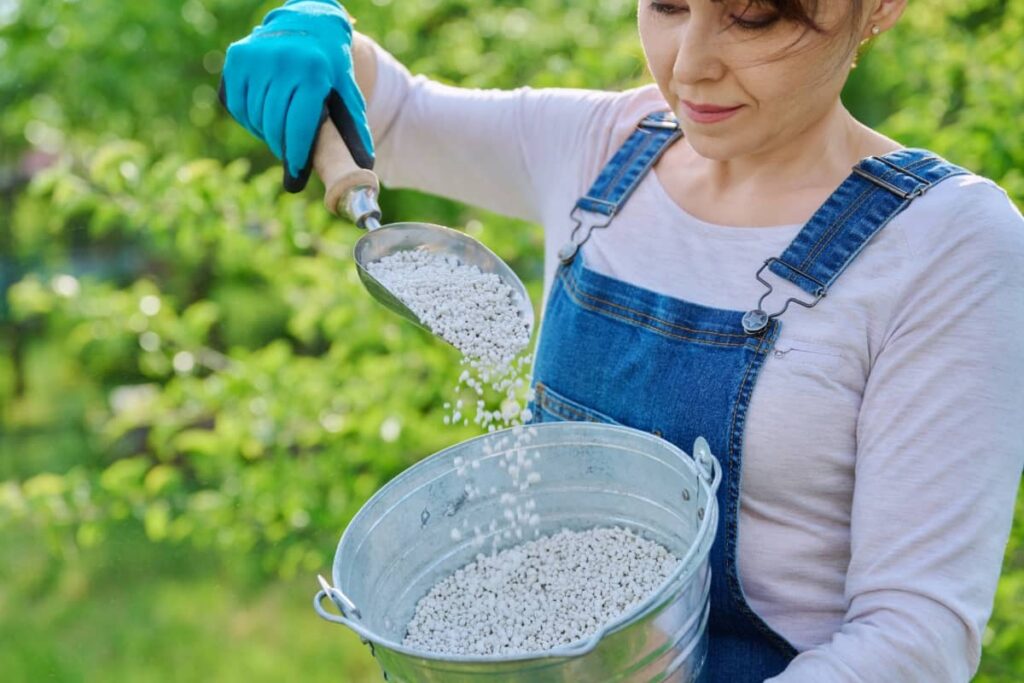Areca, Dypsis lutescens, is a palm that is a popular houseplant. Areca Palms are known for their lush, tropical foliage and graceful appearance. Fertilizers help improve soil fertility. By adding fertilizer to the soil around your palms, you replenish these nutrient levels and create an optimal environment for healthy root development.

Best Fertilizer for Areca Palms
Nutrient Requirements for Areca Palms
The nutrient requirements for Areca Palms are essential for their overall health and growth. These palms thrive in well-drained soil with a slightly acidic to neutral pH level. To provide them with the necessary nutrients, it is important to understand their specific needs.
Moreover, fertilizers can enhance the aesthetic appeal of Areca Palms by promoting lush green foliage and encouraging more abundant flowering. They can make a noticeable difference in terms of leaf coloration, size, and texture. Choosing the right fertilizer for your indoor Areca Palms is crucial to their overall health and growth.
Organic Fertilizers
Organic fertilizers are an excellent nutrient for those looking to maintain the health of their Areca Palms in a natural and eco-friendly way. They provide essential nutrients to the plants without the use of synthetic chemicals. The advantage of organic fertilizers for Areca Palm is that they improve the soil structure, allowing better water retention and nutrient absorption by the roots.
Another benefit is that using organic fertilizers helps promote beneficial microbial activity in the soil. When choosing an organic fertilizer for your Areca Palms, look for options like composted cow manure or worm castings. The best organic fertilizers for Areca Palm are compost, worm castings, Seaweed extract, and fish emulsion.
Slow-Release Fertilizers
These fertilizers provide a steady nutrient supply over an extended period, ensuring that your areca palm receives a consistent and balanced diet. Slow-release fertilizers for Areca Palm work by releasing nutrients gradually, which helps prevent nutrient burn and reduces the risk of over-fertilization. This slow release also means that you don’t have to apply fertilizer as frequently, making it convenient for busy gardeners. The advantage of using slow-release fertilizers is their ability to enhance soil fertility over time.
Liquid Fertilizers
Liquid fertilizers are a popular choice among plant enthusiasts, and they can be an effective option for nourishing your Areca Palms. These fertilizers come in liquid form, making it easy to apply foliage to your plants. Liquid fertilizers also offer versatility in terms of application methods. You can dilute them with water and apply them as a foliar spray or drench the soil around the base of your Areca Palms. While liquid fertilizers may offer convenience and immediate results, it’s important not to overdo it when applying these products.
Natural Fertilizer for Areca Palm
The popular natural fertilizer for areca palms is compost. This helps improve soil structure, retain moisture, and slowly release nutrients over time. Another great natural option is seaweed extract. Packed with beneficial minerals and trace elements, seaweed extract provides a boost of nutrition while enhancing the overall health of your areca palm. Additionally, using worm castings as fertilizer can work wonders for your plants. By opting for natural fertilizers like compost, seaweed extract, and worm castings, you not only support the health of your areca palm but also contribute to sustainable gardening practices.
NPK for Areca Palm
Areca palms have specific nutrient requirements for optimal growth, and using the right fertilizer can make a significant difference. The best Areca palms N-P-K ratio is 3-1-3 or 3-1-2. This balanced ratio ensures that the palm receives adequate nutrients without promoting excessive foliage growth at the expense of root development. It allows the plant to maintain its vibrant green color while supporting strong roots and overall health.
Vermicompost for Areca Palm
Vermicompost, also known as worm castings, is a fantastic organic fertilizer for Areca Palms. Made from the waste produced by earthworms during the decomposition of organic matter, vermicompost is rich in many nutrients that are beneficial for plant growth. To apply vermicompost to your Areca Palm, spread a thin layer around the plant base or incorporate it into the surrounding soil. Avoid piling up too much near the trunk, as this can cause rotting.
In case you missed it: Arecanut Production – A Beginners Guide

Regular application of vermicompost throughout the growing season will provide ongoing nourishment for your Areca Palm. Consider incorporating it into your fertilizing routine every 2-3 months to maintain optimal nutrient levels in the soil.
Fertilizing Areca Palms Seasonally
During the spring and summer months, when Areca Palms are actively growing, it’s best to apply a slow-release fertilizer. In contrast, during the fall and winter months, when growth slows down, reducing or even suspending fertilization is recommended. Understanding your local climate will help you determine the ideal timing for Areca Palm fertilization based on your specific area.
Fertilizing Frequency for Areca Palms
The frequency of fertilization will depend on several factors, such as the age of the plant, the size of the pot or container it’s in, and the type of fertilizer used. For younger Areca palms, it’s recommended to fertilize every two months during the spring and summer seasons using a balanced slow-release fertilizer. Older plants may only need to be fertilized once every four months. It’s important not to over-fertilize the Areca palm as this can cause damage the roots.
How to Apply Fertilizer to Areca Palms
It’s important to choose a slow-release fertilizer specifically formulated for Areca palm trees. This type of fertilizer slowly releases nutrients over time, providing a steady supply without overwhelming the plant. You can find these fertilizers at your local garden center or online. When applying the fertilizer, start by measuring out the recommended amount based on the instructions provided.
Next, evenly distribute the measured amount around each palm tree, making sure to avoid piling it up against the trunk. Spread it out in a circle around the base of each plant, extending slightly beyond its drip line. Afterward, work the granules into the soil using a small garden rake or your hands. Make sure careful not to disturb or damage any roots while doing so. To maximize absorption and prevent nutrient runoff, water thoroughly after applying fertilizer. This helps ensure that nutrients reach deep into the root zone where they are needed most.
Signs of Over- or Under-Fertilizing Areca Palms
The sign of over-fertilization for Areca Palm is leaf burn, which appears as brown or yellow spots on the leaves. This occurs when the concentration of soil nutrients becomes too high, leading to an imbalance that damages the foliage. Another indicator is stunted growth, where the palm fails to reach its full potential and remains smaller than expected. On the other hand, under-fertilization may manifest as pale or yellowing leaves. This happens because the plant is not receiving enough essential nutrients for proper chlorophyll production.
Additionally, slow growth and a general lack of vigor are commonly observed when Areca palms are not adequately fertilized. To prevent these problems, it’s crucial to find a balance in your fertilizer application. Regularly monitor your plants for any signs mentioned above and adjust your fertilizer schedule accordingly. It’s always better to start with small amounts of fertilizer and gradually increase as needed rather than risking overdoing it.
Frequently Asked Questions (FAQ on Best Fertilizer for Areca Palms
How Often Should You Fertilize Your Areca Palm?
Ideally, you should apply fertilizer every 2 to 3 months during the growing season (spring and summer). This provides a consistent supply of nutrients without overwhelming the plant.
When is the Best Time to Apply Fertilizer to My Areca Palm?
It’s best to apply fertilizer in early spring when new growth begins. Avoid fertilizing during winter or periods of dormancy when your plant won’t be actively taking up nutrients.
Is Foliar Feeding Beneficial for Areca Palms?
Foliar feeding involves spraying liquid fertilizer directly onto the leaves of your plants. While this method can be effective in delivering quick nutrients, it’s not necessary for most houseplants like the Areca palm.
In case you missed it: Types of Pink Tomatoes: Exploring 10 Best Varieties of Pink and Pink-Red Tomatoes

Conclusion
Fertilizers play a major role in the growth and health of Areca Palms. The right fertilizer can have a significant effect on the overall well-being of these tropical plants. Fertilizer has a profound impact on Areca Palm’s growth and appearance by providing essential nutrients while helping them resist diseases.
- Profitable Village Farming Business Ideas in 2024
- High-Yield Aquaculture: Fast-Growing Fish for Farming
- Effective Fish Pond Construction Techniques for Beginners
- Irrigation and Water Management in Pineapple Farming
- Blossom to Harvest: Mastering Flowering and Pollination in Papaya Farming
- Pig Fattening Essentials: From Selection to Sale for Beginners
- Raising Wagyu Cattle: A Complete Guide for Premium Beef Production
- Soil Types and Their Water Holding Capacity
- Optimizing Irrigation Schedules for Coconut Groves for Enhanced Yield
